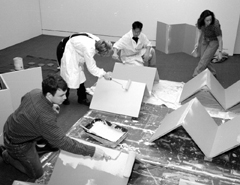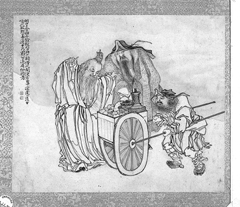The University Record, January 17, 2000 By Joanne Nesbit
News and Information Services

Five years in the planning and nearly 900 years in the making, “The Orchid Pavilion Gathering,” the first major exhibition of one of the Museum of Art’s most acclaimed collections, will open Jan. 23 and continue through March 26.
Spanning nearly 900 years, the 60 works on view provide a rare opportunity to survey the rich tradition of painting in China. Large-scale exhibitions of Chinese paintings are exceedingly rare, both because of the fragility of the works involved and the unique display requirements of large hanging or hand scrolls. Many of the paintings in the exhibition have never before been shown in the Museum galleries.
The first Chinese painting acquired by the Museum, a large hanging scroll titled “Crane on a Pine Branch,” is included in the exhibition, as are works by major Chinese artists that were acquired during the 1960s and ’70s by Richard Edwards, professor emeritus of Far Eastern art.
The exhibition takes its title from a work by Sheng Mao-yeh of the Ming dynasty (1368–1644) and depicts a traditional spring gathering of scholars during the Tsin dynasty (317–419). Acquired by a 17th-century Japanese collector shortly after it was painted, the piece was exhibited in Japan and then locked up for safe keeping for 300 years, explains Marshall Wu, curator of Asian art. In 1973, a descendent of this Japanese family encountered financial difficulties and decided to sell the scroll.

Ashamed of his need to do so, and desiring to keep the sale quiet, he took the painting to an American dealer in Kyoto—rather than to a shop owned by his countrymen. Edwards happened to be paying a call on the dealer at the moment the scroll was presented and purchased it immediately.
A two-volume exhibition catalogue carefully details the works on view and includes relevant historical data, critical biographical material on the artists and stylistic analyses of the paintings.
Behind the elegant setting for the exhibit lie years of planning, research and a well-coordinated design and construction process aimed at creating a perfect temporary home for the array of delicate works on silk and paper. “Unlike Western canvases that are stretched on wood frames,” says Kevin Canze, Museum preparator, “Chinese paintings are too delicate to hang unprotected in a public space.”
The job of creating a case prototype for works that could be as large as 13 feet in length fell to Jaye Schlesinger, an artist and cabinet maker and a new member of the Museum team. Her design solution balances aesthetics and economy with shipping considerations for the exhibition’s future venues.

Exhibition curator Wu and preparator Kirsten Neelands determined the layout of the exhibition using scale models of the gallery and the paintings. They considered the chronology of the paintings, the size of the works, traffic flow and aesthetics in determining where to locate each of the cases and explanatory text panels. Working in conjunction with Museum designer Steven Hixson, Wu and Neelands selected paint colors, typefaces and case ornamentation that lends a Chinese ambience to the gallery.
“I have worked with these paintings for most of my career,” Wu says, “but sharing them with the public in an exhibition of this scale is truly a wonderful thing.”
Museum hours are 10 a.m.–5 p.m. Tuesday–Saturday (until 9 p.m. Thursday) and noon–5 p.m. Sunday. Admission is free, but a $5 donation is suggested.

